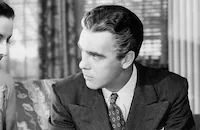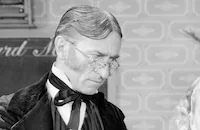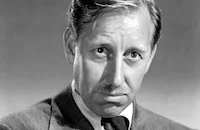Santa Fe

Brief Synopsis
Cast & Crew
Irving Pichel
Randolph Scott
Janis Carter
Jerome Courtland
Peter Thompson
John Archer
Film Details
Technical Specs

Synopsis
Shortly after the end of the Civil War, the Canfield brothers, Britt, Tom, Clint and Terry, leave the ruins of their Virginia plantation and ride northwest in search of new lives. In the saloon of a small Missouri town, two drunken Union soldiers taunt them. Despite oldest brother Britt's efforts to maintain calm, one of the soldiers draws and fires and is killed in self-defense by Tom and Clint. Knowing they stand no chance for a fair trial, the Canfields flee, jumping a westbound train, filled with men seeking work on the new Santa Fe railroad line. Later, when the railroad representative, Col. Holliday, swears men in for jobs, Britt accepts, but his brothers refuse to take the oath of loyalty to the Union. Holliday's assistant, Dave Baxter, recognizes Britt as a former member of a Confederate guerrilla band, but, despite having been with the Union forces, Dave is pleased to hire Britt under an assumed name. Meanwhile, casino owner Cole Sanders approaches Tom, Clint and Terry, promising them work. Britt works diligently as the head of a railroad gang and reports to paymaster Judith Chandler, who knows his identity and is cool to him because her husband was killed in a raid Britt led during the war. Dave is impressed by Britt's sure way with the men, trespassers and Indians, and promotes him to his assistant. Britt soon realizes that a mobile gambling saloon has been trailing the railroad outfit, swindling the workers out of their pay. Britt confronts the setup, only to discover his brothers are working for Sanders. Britt warns Sanders to keep away from the crew and demands that his brothers leave. Later, however, Dave and Britt find that Sanders has interfered with the company's surveyor, keeping the company from receiving a necessary government land grant, but Britt's quick action saves the grant. When the railroad dedicates the new line in Dodge City, Britt is pleased to see his brothers. Terry introduces Britt to his new young wife, Ella Sue, and the brothers declare their intention to work honestly to make money to return to Virginia. Soon after, however, the Santa Fe train in which Britt is riding is held up by masked bandits and a trainman is killed. Britt recognizes his brothers and confronts them. Tom, who has been wounded, admits they still work for Sanders. Marshal Bat Masterson and a wounded engineer then arrive to accuse Terry of being one of the bandits. Terry is arrested just before Tom dies. Meanwhile, Judith finds a wanted poster for the Canfields for the death of the soldier in Missouri and tells Britt. Yet when the rail line is suddenly confronted by competition from another line, Judith encourages Britt to remain loyal to the company. Britt proves the robbery witness is unreliable and once Terry is freed, departs to beat the challenging railroad line to a crucial mountain pass. Later, Sanders discovers that the payroll train arrives that night and plans another holdup with Clint and Terry. Judith worries about a robbery, but Dave assures her Masterson has set a trap to apprehend the bandits. When Britt finds out, he confides in Clint, unaware that Sanders is eavesdropping. Britt promises his brothers he will return to Virginia with them if they call off the heist and they agree. As Britt goes to resign from the rail line, Sanders blackmails Clint and Terry into robbing the train depot safe, threatening to reveal Britt's identity. After the robbery, Britt finds Ella Sue and forces her to reveal Sanders' plans. Masterson and Dave go after Sanders. Britt confesses his identity to the marshal and insists on going along. Confronting Sanders and the Canfields at another railroad junction, Britt tries to get them to give themselves up. When Sanders fires upon Britt, Terry and Clint interfere, only to be shot by Sanders, who then leaps aboard the incoming train with his henchman. Britt follows and after a harrowing fight aboard the speeding train, Britt kills both men. When the Santa Fe line opens in Santa Fe, Judith learns from Dave that Britt is working with the company on another line in Nevada, and hastens to join him.

Director

Irving Pichel
Cast

Randolph Scott

Janis Carter

Jerome Courtland

Peter Thompson

John Archer

Warner Anderson

Roy Roberts
Billy House

Olin Howlin
Allene Roberts
Jock O'mahoney

Harry Cording
Sven Hugo Borg

Frank Ferguson

Irving Pichel
Harry Tyler
Chief Thundercloud
Paul E. Burns
Reed Howes
Charles Meredith
Paul Stanton
Richard Cramer
Charles Sullivan
William Haade
Francis Mcdonald
Frank O'connor
Bud Fine
Harry Tenbrook
Frank Hagney
Al Thompson
Al Kunde
Guy Wilkerson
William Tannen

James Kirkwood
Stanley Blystone
Richard Fortune
Lane Chandler
Chuck Hamilton
Charles Evans
Roy Butler
David Hammond
William Mccormack
Art Loeb
Blackie Whiteford
Captain Fred Somers
Mike Lally
Edgar Dearing
George Sherwood
Louis Mason
Jack E. Parker
Ralph Sanford
Denny Sullivan
Rudolph Bowman
Crew
Harry Joe Brown
Francis Cugat
Kenneth Gamet
Frank Goodwin
Gene Havlick
Walter Holscher
Charles Lawton Jr.
Sam Nelson
Paul Sawtell
Louis Stevens
Herbert Stewart
Morris Stoloff
Frank [a.] Tuttle

Film Details
Technical Specs

Articles
Santa Fe
Loosely based on the 1945 novel Santa Fe: The Railroad That Built an Empire by James Marshall, Santa Fe thinks big and makes the most of its vivid Technicolor scenery shot primarily on location in beautiful Prescott, Arizona. Combining elements of drama, humor, and romance with some impressive action sequences along the way, Santa Fe has something for everyone and Randolph Scott fans will not be disappointed.
The supporting cast includes the fetching Janis Carter as Scott's love interest, with Billy House and Olin Howlin as railroad conductors that provide the film's comic relief.
Santa Fe was one of many successful collaborations between Western hero Randolph Scott and producer Harry Joe Brown. Theirs was a frequent partnership that lasted nearly 20 years and produced such films as Decision at Sundown (1957), Ride Lonesome (1959), and Comanche Station (1960).
Producer: Harry Joe Brown
Director: Irving Pichel
Screenplay: Kenneth Gamet, Louis Stevens (story), James Vance Marshall (novel)
Cinematography: Charles Lawton, Jr.
Film Editing: Gene Havlick
Art Direction: Walter Holscher
Music: Paul Sawtell
Cast: Randolph Scott (Britt Canfield), Janis Carter (Judith Chandler), Jerome Courtland (Terry Canfield), Peter Thompson (Tom Canfield), John Archer (Clint Canfield), Warner Anderson (Dave Baxter).
C-87m.
by Andrea Passafiume

Santa Fe
Santa Fe
Santa Fe is a case in point. Based on a novel by James Vance Marshall called Santa Fe, the Railroad That Built an Empire, it's about four brothers from the south, who, bitter over the loss of their plantation after the Civil War, head west. Scott takes a job with the Santa Fe Railroad, but his three brothers become outlaws; inevitably, Scott must battle them while building the railroad and romancing lovely Janis Carter.
Reviews of the time all praised the fast, action-packed entertainment value of Santa Fe, which was photographed in Technicolor by Charles (Buddy) Lawton, Jr., an ace cameraman who would shoot nine Scott westerns in all, including three for director Budd Boetticher. The Hollywood Reporter described the film as a "big time western...vigorous, convincing adventure fare...superbly photographed." Daily Variety called the story "topnotch... a worthy credit right down the line for producer Harry Joe Brown." And weekly Variety praised the script for "an expert job of establishing character without overlooking any opportunities to introduce action -- the most essential ingredient for this type of feature. Irving Pichel's direction is fast and rugged."
This was one of Pichel's last films, as he would die of a heart attack three years later. While he is forgotten today, and has never been especially lauded by modern film historians, he did direct three dozen features and proved himself adept at a variety of genres and styles, including thrillers like The Most Dangerous Game (1932), dramas like The Man I Married (1940), comedies like The Bride Wore Boots (1946), film noir like They Won't Believe Me (1947), science fiction like Destination Moon (1950), and westerns. Pichel also discovered Natalie Wood, casting her in bit roles in two 1943 films (Happy Land and The Moon Is Down) before giving her much more significant parts in Tomorrow Is Forever (1946) and The Bride Wore Boots.
According to author Robert Nott (The Films of Randolph Scott), actor John Archer once described Pichel as "a very easygoing, swell guy. He had an actor's approach because he was an actor. [He was] very protective..., very understanding and very good. He could give you a lot." Pichel, in fact, has a small acting part in Santa Fe, playing a character named "Harned."
Some final trivia notes:
At one point, this film purports to illustrate where the names of the famous railroad lines "Chief" and "Super Chief" came from. After an Indian hops on board and drives a locomotive in one sequence, Randolph Scott tells him, "You're all right, chief. Maybe some day we'll name a train after you."
Santa Fe opened on a double bill with the 'B' film Fury of the Congo (1951), a Jungle Jim movie starring Johnny Weissmuller -- "an opus of which nobody can be proud," the L.A. Examiner critic wrote.
Producer: Harry Joe Brown
Director: Irving Pichel
Screenplay: Kenneth Gamet, Louis Stevens (story), James Vance Marshall (novel)
Cinematography: Charles Lawton, Jr.
Film Editing: Gene Havlick
Art Direction: Walter Holscher
Music: Paul Sawtell
Cast: Randolph Scott (Britt Canfield), Janis Carter (Judith Chandler), Jerome Courtland (Terry Canfield), Peter Thompson (Tom Canfield), John Archer (Clint Canfield), Warner Anderson (Dave Baxter).
C-87m.
By Jeremy Arnold
Santa Fe
Quotes
Trivia
Notes
According to Hollywood Reporter news items, portions of this film were shot on location in Prescott, AZ. Although a Hollywood Reporter production chart includes Robert Shayne in the cast, his appearance in the completed picture has not been confirmed.














